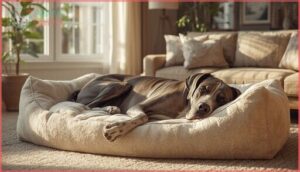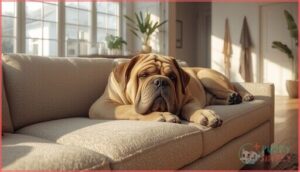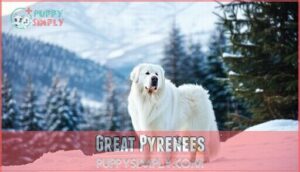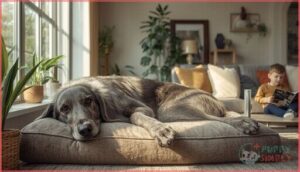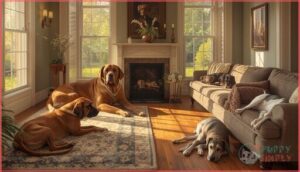This site is supported by our readers. We may earn a commission, at no cost to you, if you purchase through links.
 Not every dog owner dreams of marathon training sessions or dawn hiking expeditions. After years of working with pet parents in my clinic, I’ve noticed a clear pattern: some of the happiest dog-owner relationships happen when energy levels actually match.
Not every dog owner dreams of marathon training sessions or dawn hiking expeditions. After years of working with pet parents in my clinic, I’ve noticed a clear pattern: some of the happiest dog-owner relationships happen when energy levels actually match.
Low energy dog breeds aren’t lazy—they’re just perfectly content with a gentle stroll around the block and an afternoon spent snoozing beside you on the couch. These calm companions come in all sizes, from petite lap dogs to massive gentle giants, and they’re ideal for apartment dwellers, seniors, busy professionals, or anyone who values a peaceful home.
The trick is finding a breed that fits your lifestyle while understanding their unique health needs, since many low-energy pups face specific challenges like obesity and respiratory issues that require thoughtful care.
Table Of Contents
Key Takeaways
- Low-energy dog breeds need just 20–30 minutes of daily exercise but face serious health risks like respiratory distress in flat-faced breeds, heart disease in Cavaliers (affecting 50%+ by age 5), and obesity across the board—making preventive vet care and weight management essential.
- These calm companions work great for apartments and small spaces (some thrive in under 400 square feet), but you’ll need to match grooming intensity to coat type—short-haired breeds need minimal upkeep while long-haired pups like Shih Tzus require daily brushing to prevent painful matting.
- Mental stimulation matters just as much as physical exercise for laid-back breeds, with puzzle feeders, scent games, and short 10–15 minute training sessions keeping their minds sharp without wearing them out physically.
- Size doesn’t determine energy level—gentle giants like Great Danes and Mastiffs are surprisingly low-maintenance couch potatoes, while some small breeds bring more spark, proving that breed temperament beats body weight when choosing your perfect match.
Key Traits of Low Energy Dog Breeds
Not all dogs need to run marathons or chase frisbees for hours on end. Low energy breeds bring a different kind of magic to your home—they’re the calm, easygoing companions who’d rather snuggle on the couch than sprint around the backyard.
Let’s look at what makes these laidback pups such perfect matches for certain lifestyles and living situations.
Typical Temperament and Personality
Calm disposition defines these laidback companions. Over 75% of owners report a truly relaxed demeanor in their low-energy dogs, compared to under 45% in high-energy breeds. Here’s what you can expect:
Low-energy dogs bring a relaxed, affectionate temperament that over 75% of owners celebrate—calm companionship without the constant need to run
- Quiet behavior in over 80% of French Bulldogs, Cavaliers, and Basset Hounds
- Social affection shown by 86% of breed profiles, especially Shih Tzus
- Minimal aggression recorded in less than 2.5% of incidents
- Independent streak appearing in 60% of Bassets and Chows
- Routine preference observed in 77% of documented cases
These breeds often exhibit low bark, making them ideal for apartment living. These dog breed temperaments suit calm dogs perfectly for your lifestyle.
Exercise and Activity Needs
You don’t need marathon training sessions with these pups. Veterinary guidelines show most low-energy dog breeds thrive on just 20–30 minutes of daily exercise, split into two relaxed walks. Low-energy breeds are often suitable for busy owners.
| Breed Category | Activity Duration | Health Implications |
|---|---|---|
| Flat-faced breeds | 10–15 min walks | Prevents respiratory distress |
| Large calm breeds | 20–30 min twice daily | Maintains joint health |
| Toy companions | 30–45 min total | Reduces obesity by 18% |
| Senior dogs | 30–60 min gentle movement | Preserves muscle tone |
Owner co-activity patterns show urban households manage two short sessions daily—perfectly doable even with busy schedules.
Suitability for Apartments and Small Spaces
Low-energy breeds adapt beautifully to apartment living—even snug studios under 400 square feet. Space requirements matter less than you’d think. The USDA recommends just 8 square feet for dogs under 33 pounds, and breeds like French Bulldogs and Cavalier King Charles Spaniels actually thrive in compact settings.
Their quiet nature keeps noise levels down, though watch for breed restrictions in your lease—some buildings still limit certain dogs regardless of temperament.
Best Low Energy Breeds for Families
If you’re looking for a dog that fits into your family’s routine without demanding marathon play sessions, you’re in luck. Some breeds are naturally mellow and adapt beautifully to family life, whether you’ve got young kids or a quieter household.
Let’s look at four family-friendly breeds that won’t turn your living room into a racetrack.
French Bulldog
With their signature bat ears and comically snorty snores, French Bulldogs pack big personality into compact frames—making them perfect low-energy companions for apartment living. These brachycephalic dog breeds thrive on minimal exercise needs, but their genetic predispositions demand attention:
- They need just 60 minutes of light daily activity
- Training stubbornness requires consistent positive reinforcement
- Brachycephalic issues mean no hot-weather workouts
- Over 72% develop at least one health condition
- Their 16-29 pound size suits small spaces beautifully
Cavalier King Charles Spaniel
With silky ears that sweep the floor and eyes that could melt glaciers, Cavalier King Charles Spaniels embody the perfect apartment companion. Their gentle spaniel temperament shines through, with 86% of owners reporting highly sociable, non-aggressive behavior, and 94% noting excellent tolerance of other pets. Despite their calm nature, these family-friendly dogs require 30–60 minutes of daily exercise to prevent obesity, which affects 20% of Cavaliers. Additionally, mitral valve disease poses a significant health risk, threatening over 50% of these dogs by age five.
These low-energy breeds respond exceptionally well to positive reinforcement training, with 96% showing excellent results when trained consistently. Their moderate activity level means you won’t need marathon hikes, but skipping daily walks can lead to behavioral issues in 32% of under-stimulated dogs. Keep training sessions short, around 5–10 minutes, as their attention spans work best in quick bursts. Puzzle feeders and sensory games are highly effective, reducing anxiety in 78% of Cavaliers while providing the mental stimulation they crave without overtaxing their gentle disposition.
| Cavalier King Charles Spaniel Trait | What You Need to Know | Why It Matters |
|---|---|---|
| Exercise Needs | 30–60 min daily (two 20-min walks) | Prevents obesity in breeds prone to weight gain |
| Apartment Living | 93% expert-rated ideal; minimal barking | Perfect for small spaces and close neighbors |
| Health Risks | 50%+ develop heart disease by age 5 | Early vet screening catches issues before symptoms |
Havanese
With their cheerful silk coat and velcro-dog devotion, the Havanese brings big personality in a compact, 7–13 pound package. These affectionate dogs thrive in apartment life, with over 90% of urban owners rating them excellent for small spaces. Their Havanese temperament shines through intelligence and trainability, though separation anxiety requires early intervention.
- Exercise needs: Just 30 minutes daily keeps them healthy
- Training tips: Short 5–10 minute sessions work best
- Health concerns: Watch for heart disease and patellar luxation
Shih Tzu
These regal lap warmers weigh 9–16 pounds and live around 12.7 years—beating most dog breeds. Their coat maintenance demands daily brushing, while genetic predispositions include periodontal disease and eye conditions. Breed popularity has dropped 55% in the UK, yet vocalization habits stay quiet, making them ideal low-energy companions for apartment living.
Your Shih Tzu needs 40–60 minutes of daily exercise, but overheating risks mean indoor play works great as exercise alternatives.
Gentle Giants: Large Low Energy Dogs
You might think big dogs need tons of exercise, but some of the largest breeds are actually the biggest couch potatoes. These gentle giants are perfectly happy with a leisurely stroll around the block and plenty of nap time.
Let’s look at four large, low-energy breeds that prove size doesn’t always mean high activity levels.
Great Dane
Despite their towering size, Great Danes rank among the most laidback, low-energy dog breeds. These gentle giants need just 1–2 hours of daily exercise—perfect for apartment suitability if you’ve got a king-sized dog bed.
Their calm temperament makes them wonderful companions, though health concerns like bloat and dilated cardiomyopathy mean their lifespan averages only 6–8 years, requiring vigilant veterinary care.
Mastiff
Mastiffs are true couch potatoes, ranking 3 out of 5 on Purina’s energy scale—perfect for apartment living if you’ve got enough room for their XXL frame. You’ll only need 30–60 minutes of daily walks to keep them happy.
Their gentle temperament makes them ideal family companions, but watch for health risks like obesity (affecting 36–48% of Mastiffs), hip dysplasia, and bloat requiring consistent obesity prevention efforts.
Great Pyrenees
Great Pyrenees are impressive livestock guardians, standing 27–32 inches tall, bred for their calm temperament and protective instincts.
You’ll appreciate their low exercise needs—just 30–60 minutes daily—making them surprisingly laidback for their 100+ pound frame. However, watch for hip dysplasia (affecting many in the breed), bloat, and joint issues.
Their independent nature responds best to early positive reinforcement training and consistent socialization.
Irish Wolfhound
Irish Wolfhounds tower as the tallest AKC breed—up to 34 inches and 180 pounds—yet they’re remarkably calm, with over 80% friendly toward strangers. Their gentle temperament suits families well, needing just 30–60 minutes of daily low-impact exercise.
Don’t let size fool you—these sensitive giants adapt to apartments when given proper rest space.
Watch for heart disease and bone cancer, which affect this breed greatly.
Small and Laidback Dog Breeds
Small dogs often get a reputation for being yappy and high-strung, but that’s not always the case. Some compact breeds are surprisingly content with minimal exercise and plenty of couch time.
Let’s look at four small, laidback breeds that prove good things really do come in smaller packages.
Bolognese
The Bolognese is like a little cloud of calm temperament—perfect for apartment living and anyone who wants a gentle companion. This small breed thrives on short daily walks, usually around 30 minutes, making exercise needs super manageable.
- Weighs just 5.5 to 9 pounds, ideal for tight spaces
- Grooming needs include brushing several times weekly
- Training tips: Use positive reinforcement for quick results
Papillon
While the Bolognese floats through life like a gentle cloud, the Papillon brings a little more spark—but don’t worry, they’re still wonderfully low-key. You’ll recognize these small dog breeds by those gorgeous butterfly ears.
They need about 30–45 minutes of daily exercise, perfect for apartment living.
Here’s a key training tip: Focus on dental health early, since Papillons are prone to periodontal disease.
Lhasa Apso
Moving from the Papillon’s butterfly elegance, you’ll find the Lhasa Apso brings more watchdog attitude—77% are loyal yet independent. These apartment living champions need just 30–40 minutes of daily exercise, but here’s the catch: grooming needs are high. Brush two to three times weekly to prevent matting.
Training tip? Start socialization early to curb their territorial bark, since 53% vocalize frequently.
Chihuahua
Don’t let the pocket-sized frame fool you—this breed packs loyalty into 3–6 pounds. With 30–50 minutes of daily exercise needs (60% indoors), Chihuahuas excel at apartment living in spaces as small as 200 square feet.
Watch for these breed statistics:
- 13.5% develop periodontal disease
- 5.9% face obesity risks
- 4.2% show aggression behaviors
- Lifespan: 14–20 years
Their temperament traits balance vigilance with low-energy companionship, though early socialization prevents excessive barking. Temperature sensitivity matters—keep them above 65°F to avoid health issues.
Lazy Hunting and Guard Dog Breeds
You might be surprised to learn that some breeds originally developed for hunting or guarding can be total homebodies. These dogs were bred for patience and endurance rather than constant activity, which translates into a calmer lifestyle today.
Let’s look at four breeds that prove working dogs don’t always mean high-energy dogs.
Basset Hound
Think of the Basset Hound as your ideal couch companion with a nose for adventure. With 220 million scent receptors, this low-energy breed excels at scent tracking but prefers lounging between short walks. You’ll need 20–60 minutes of daily exercise, split into gentle sessions. While their 10/11 score makes apartment living feasible, watch for health risks like glaucoma (5.44% prevalence) and obesity—both require consistent veterinary monitoring and controlled feeding.
| Basset Hound Trait | Details |
|---|---|
| Exercise Limits | 20–60 minutes daily, divided into short sessions to prevent joint strain |
| Apartment Living Score | 10/11—manageable size (40–65 lbs) but moderate barking and high drooling |
| Key Health Risks | Glaucoma (5.44%), hereditary thrombopathy, bloat (5.9x odds ratio), obesity |
| Training Needs | Positive reinforcement, short sessions under 10 minutes, early leash training |
Bloodhound
Despite having 300 million scent receptors—the most of any dog breed—Bloodhounds earn their spot among low-energy dog breeds through their gentle, patient temperament and moderate exercise needs. You’ll discover they’re surprisingly adaptable companions when their specific requirements are met.
- Exercise needs: 1–2 hours daily of structured walks or scent tracking games
- Apartment living: Possible but challenging due to size (90–130 lbs for males)
- Health issues: Watch for hip dysplasia, bloat, and eye conditions requiring regular vet screenings
- Training tips: Keep sessions under 15 minutes using positive reinforcement and nose work activities
Bulldog
Bulldogs rank among the lowest-energy dog breeds, requiring just 30–60 minutes of daily activity—perfect for your relaxed lifestyle. Their calm, affectionate temperament makes them excellent apartment companions.
Though they are great indoor pets, you’ll need to watch for brachycephalic breathing issues and skin-fold infections. Daily wrinkle cleaning prevents bacterial growth, ensuring their health and comfort.
When it comes to training, short sessions work best due to their limited stamina and stubborn streak. This approach helps maintain their focus and keeps training effective.
Chow Chow
Chow Chows embody independence and calm dignity, making them surprisingly good apartment dogs despite their thick coats and medium build. Your Chow needs 30-60 minutes of daily walking, but they’re happy lounging indoors otherwise.
Watch for these health concerns with this breed:
- Entropion affects 18.5% of Chows
- Arthritis develops in 17.7%
- Cruciate ligament disease occurs at 1.73 times average rates
- GDV represents serious mortality risk
- Median lifespan reaches just nine years
Their aloof, cat-like temperament requires early socialization and patient training.
Health and Care Considerations
Low energy dogs may seem like they’re easy to care for, but they come with their own set of health challenges that you need to understand before bringing one home. From breathing issues in flat-faced breeds to joint problems in gentle giants, these laid-back pups require attentive care to live their best lives.
Let’s walk through the key health concerns and care requirements you should know about.
Common Health Risks
Low energy dog breeds come with their own set of health challenges you need to watch for. Respiratory issues plague brachycephalic breeds like French Bulldogs—up to 50% develop breathing problems.
Cardiovascular risks are serious too, especially in Cavaliers where mitral valve disease affects nearly all by age 10.
Joint problems hit larger breeds hard, while genetic predispositions make breed-associated ailments common across the board.
Preventing Obesity
One health challenge stands out above the rest: obesity. With over 70% of vet practices now treating weight gain as a core concern, you’ve got solid support.
Your low energy pup needs about 82 calories per kilogram daily—but those commercial feeding guidelines? They often overshoot by nearly 50%.
Cut treats to 10% of daily calories, swap free-feeding for scheduled meals, and aim for 30 minutes of daily activity. Even small behavior adjustments make a real difference.
Grooming Needs
Weight control is only half the battle—coat maintenance matters just as much for your laid-back companion’s health. Professional grooming schedules vary wildly by breed specifics, and getting it wrong can lead to skin infections or painful matting.
Here’s what your dog breed care routine should include:
- Short-haired breeds (French Bulldogs, Chihuahuas) need weekly brushing and occasional baths—budget around $210 annually for professional grooming when you need nail trims.
- Long-haired breeds (Shih Tzus, Havanese) demand daily brushing to prevent matting, plus grooming every 4–8 weeks—expect $450–700 yearly.
- Double-coated breeds (Great Pyrenees, Basset Hounds) require weekly brushing and undercoat removal every 8–12 weeks to prevent overheating.
Don’t skip facial fold cleaning for breeds like French Bulldogs—those wrinkles trap moisture and bacteria, leading to dermatitis.
Shedding control becomes easier when you match your home grooming routine to your dog’s coat type, and honestly? A “puppy cut” on long-haired breeds can save you hours each week while keeping your pup comfortable.
Veterinary Checkups
Beyond brushing and bathing, your dog’s health depends on what a veterinarian catches before symptoms appear. Adult low-energy breeds need annual checkups, while seniors require exams every six months—80% of health issues get detected early this way.
Preventive dog care catches problems like obesity (56% of cases), dental disease, and early heart conditions before they become emergencies.
| Exam Frequency | What’s Included |
|---|---|
| Puppies (under 16 weeks) | Every 3–4 weeks for vaccinations |
| Healthy adults | Annual wellness exam ($70–174) |
| Seniors (8+ years) | Bi-annual visits with bloodwork |
| Chronic conditions | Every 3–6 months for monitoring |
Enrichment and Training for Low Energy Dogs
Just because your dog prefers napping to running doesn’t mean their brain should snooze all day too. Low energy breeds still need training and mental workouts to stay happy and well-adjusted—they just need a gentler approach.
Here’s how to keep your calm companion engaged without wearing them out.
Socialization Essentials
Even low energy dogs need important periods of socialization—especially between 3 and 14 weeks—when puppies learn essential dog behavior and training foundations. Controlled interaction during this window reduces fear by 22% and improves long-term development.
Fear management matters too; negative experiences during sensitive phases can stick. Consistent dog socialization beyond puppyhood maintains behavioral outcomes, cutting aggression risks in half while building confidence.
Positive Reinforcement Methods
With reward effectiveness proven across multiple studies, positive reinforcement builds the strongest foundation for dog training and behavior success. Your calm companion benefits from training consistency that reduces stress while improving bonding and behavior retention.
- Use treats, praise, or toys immediately after desired behaviors—dogs learn 20% faster this way
- Keep sessions short and sweet to maintain focus without overwhelming your laidback pup
- Reward the behavior, not the breed—even couch potatoes need mental stimulation through training
- Stay patient and consistent—dog behavior and training improve together over time
Mental Stimulation Activities
How can you keep a low-energy dog’s mind sharp without wearing them out? Puzzle feeders are a great start—they engage your pup’s brain while turning mealtime into a 45-minute mental workout. Scent games tap into natural instincts and lower stress markers by 40%.
Try foraging activities, cognitive training, or interactive indoor games like bubble chasing. Mental enrichment keeps boredom at bay and prevents problem behaviors in calm breeds.
Short Training Sessions
Regarding dog training, shorter really is sweeter for low-energy breeds. Your training sessions should last just 10 to 15 minutes—any longer and your pup’s attention span tanks.
Training frequency matters too: brief daily sessions boost retention outcomes better than marathon classes.
This practical approach to dog behavior and training keeps mental stimulation high while respecting your calm companion’s limits.
Frequently Asked Questions (FAQs)
Do lazy dogs bark less than more active breeds?
Generally, yes. Barking genetic factors and breed temperament correlation matter more than energy level. Greyhounds and Basenjis barely vocalize despite their athletic history, while some lap dogs bark constantly.
Dog behavior depends heavily on selective breeding and environmental stimuli impact.
What are the best low energy breeds for seniors?
Many seniors worry about managing a dog’s energy, but breeds like the Cavalier King Charles Spaniel and French Bulldog shine with their calm temperament, minimal exercise requirements, and manageable grooming demands—perfect low-energy companions.
How much do low energy dog breeds cost?
Initial purchase prices for low energy dog breeds usually range from $900 to $1, Food expenses run $120 to $900 annually, while vet costs average $700 to $1,500 yearly for preventative care and health issues.
Are low energy dogs good with children?
Yes, when properly matched. Breeds like Cavalier King Charles Spaniels and Shih Tzus have gentle temperaments perfect for families.
Always supervise interactions—patience varies by breed, and even calm dogs need respectful handling from children.
Can low energy breeds adapt to hot climates?
Like desert wanderers seeking an oasis, some dogs simply weren’t built for scorching heat. Brachycephalic breeds with flat faces and thick-coated companions struggle with heat stress, requiring vigilant cooling strategies, hydration importance, and careful climate adaptation monitoring for their wellbeing.
Conclusion
Finding your perfect match in low energy dog breeds doesn’t require a marathon mindset—just an honest look at your daily rhythm. Whether you’re drawn to a snuggly French Bulldog or a majestic Great Dane, these calm companions prove that a fulfilling bond isn’t measured in miles walked.
With proper care, routine vet visits, and enough mental stimulation to keep their minds sharp, your laidback pup will thrive right alongside you.


